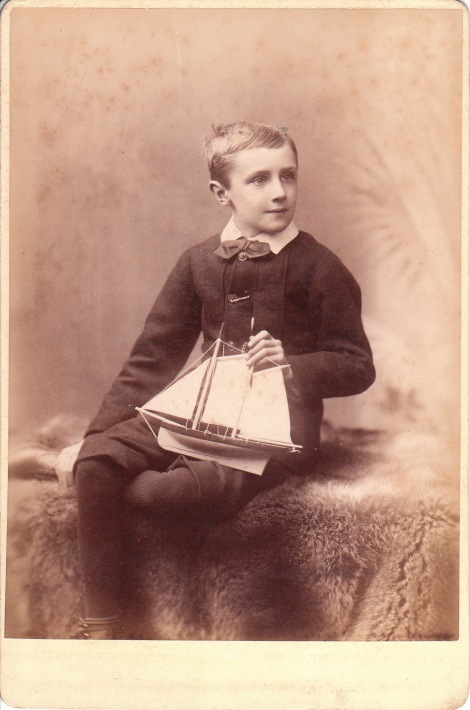This cabinet card features a well dressed young boy and his toy sail boat. One can imagine the boy playing with this realistic looking model boat in a local pond or lake. The boy his wearing a bow tie and a happy expression The reverse of this photograph has advertising for the photographer, Thomas Fall. His studio was located at “10 Wellington Terrace, (opposite Kensington Palace Gardens), Bayswater W”. Thomas Fall (1833-1900) started as a lithographer and later worked as chief photographer for the famed English photographic gallery, Elliot and Fry. He began at that prestigious firm in 1867 and worked there for seven years. Click on the category “Photographer: Elliot and Fry” to view some of the firms images. He married Sarah Maria Farmer in 1863 and the couple had six children. Fall was a well known photographer, photographed royalty, and was London’s leading canine photographer.
BEAUTY FROM THE PLAINS: LENA BRINGS HIGH FASHION TO GRAFTON, NORTH DAKOTA
A pretty young woman wearing an unusual dress poses for her portrait at the Rindahl studio in Grafton, North Dakota. This plains beauty is anything but plain in her dress which features giant buttons and a high collar. She is wearing a collar pin. The reverse of the photograph lists the name of this fashionable lady as “Lena Larson”. Lena B. Larson appears in the 1920 and 1930 United States census. Lena was born in 1884 and was married to Olaf Larson who was a farmer and two years her junior. In 1920 and 1930 she was living in Kensington, North Dakota. The 1930 census indicates that Lena had six children aged three to seventeen. Records indicate that she died in 1967 at the age of 83 and was buried in Park River, North Dakota. The photographer of this image is J. O. Rindahl. According to the book, “North Dakota of Today” (1919), Rindahl (1862-?) was born on a farm in Wisconsin. He had a childhood interest in painting but because of strains caused by being a member of a family of twelve, he had limited art instruction. He “drifted” into photography, a field in which he was quite successful. In 1895 he went abroad and visited a number of “renowned art galleries”. This experience caused his passion for painting to reemerge and when he returned to Grafton he used his spare time to pursue painting. The book features some of his paintings and several North Dakota churches displayed his paintings. In addition to religious paintings, he was known as a landscape painter. Rindahl had a partner in his photography business for fifteen years. Henry Ball and Rindahl occupied a studio on Main Street for at least some of those years. The St. Louis & Canadian Photographer (1902) announced that Ball sold the studio to Rindahl. The Bulletin of Photography (1922) reported that Rindahl sold the studio in Grafton, after operating it there for thirty-three years. The buyer was Arvid Rydholm of Minneapolis, Minnesota.
,

